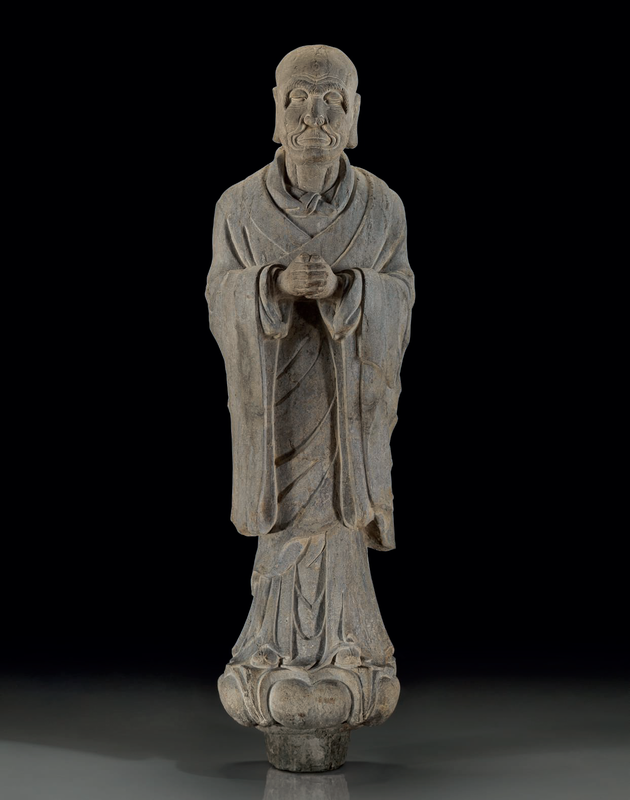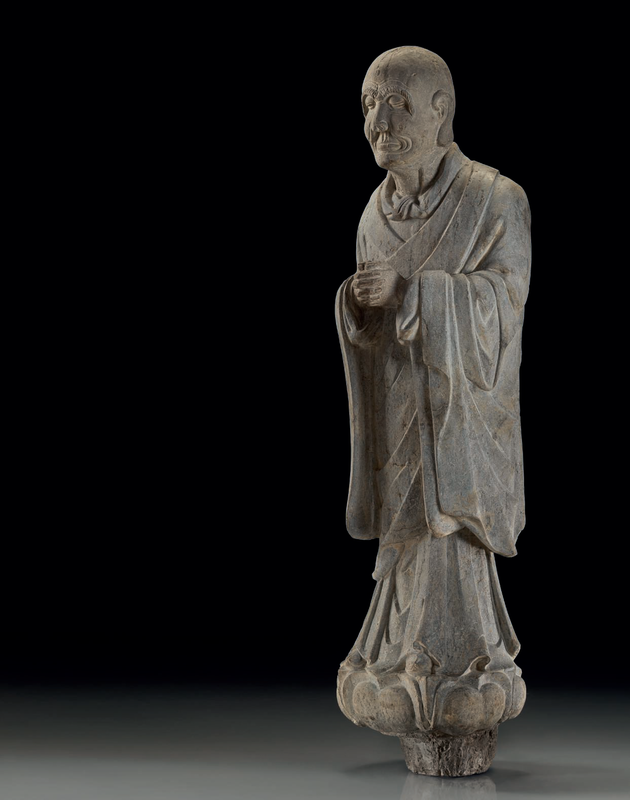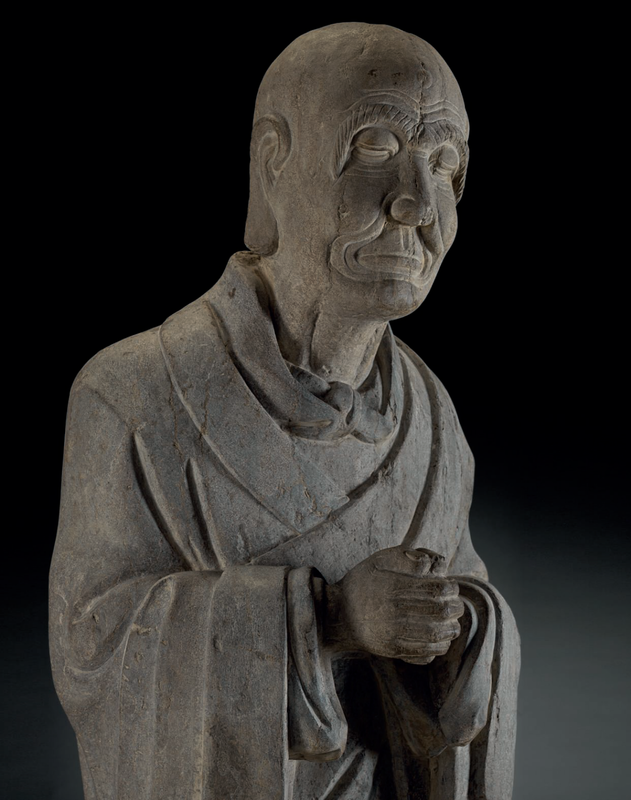Christie's. Fine Chinese Ceramics and Works of Art, New York, 13 - 14 September 2018
A large grey stone standing figure of Kasyapa, Liao-Song dynasty (AD 907-1279)
Lot 1127. A large grey stone standing figure of Kasyapa, Liao-Song dynasty (AD 907-1279); 68 7/8 in. (174.5 cm.) high. Estimate USD 300,000 - USD 500,000. Price realised USD 324,500. © Christie's Images Ltd 2018.
The aged, bald figure is shown standing on a lotus base wearing long layered robes, his hands clasped before his chest, and his head inclined slightly forward. His face is well carved with strong features set in a severe expression, and his long eyebrows curve down over his eyes.
Provenance: C.T. Loo/Frank Caro Gallery, New York.
J.T. Tai & Co., New York, 23 June 1965.
Arthur M. Sackler Collection.
The Arthur M. Sackler Foundation.
Exhibited: On loan: St. Bonaventure, New York, Regina Quick Center for the Arts, St. Bonaventure University, August 2009 - 2015.
Note: A luohan (the Chinese transliteration of the Sanskrit word, arhat) was originally the term referring to those that had achieved a certain degree of enlightenment, but by the Tang dynasty in China (AD 618- 907), luohan were considered the disciples of Buddha Shakyamuni who maintain his teachings until the coming of the Future Buddha, Maitreya. The political strife of the 7th and 8th centuries left many devotees calling for Maitreya’s arrival, and thus elevated the importance of the luohan. That popularity endured for centuries after, even during times of relative peace and prosperity in China.
Prior to the 7th century, luohans were generally represented as a pair flanking an image of Buddha, usually identified as Kasyapa, like the present figure, and Ananda, and were both two of the ten principle disciples of Buddha and important figures in the early Buddhist sangha (monkhood). In these depictions, the figures are usually shown with foreign, “Indian,” features and one is older than the other. Such an arrangement can be found in the Northern Wei-era Central Bingyan Cave at Longmen (see A. Howard, et al., Chinese Sculpture, New Haven, 2006, p. 238, fig. 3.39) and a niche at the Huangze Monastery in Sichuan Province, carved in the Northern Zhou period (ibid., p. 289, fig. 3.94).
Complete large-scale stone figures of Kasyapa are very rare, and very few examples appear to have been published. One very similar, but smaller (122 cm.) stone figure of Kasyapa from the collection of the Palace Museum Beijing, dated to the Northern Song dynasty, is published by Li Jingjie, Essence of Buddhistic Statues (shifou xuancai), Beijing, 1995, p. 160, no. 140 and discussed on p. 242. This example has very similarly rendered strong facial features, including long eyebrows that curve down towards his eyes, and is also wearing long loose robes with hands clasped together before his chest. Li states that the drapery and knot on the robes of the Palace Museum Kasyapa are similarly rendered to those on a statue of a monk in Tang county, which is dated to the third year of yuanfu, corresponding to A.D. 1100 in the Song dynasty.
Compare, a stone head of a luohan with similarly rendered facial features but a more joyful expression, in the collection of the Rijksmuseum, is illustrated in Hai-Wai Yi-Chen (Chinese Art in Overseas Collections; Buddhist Sculpture), National Palace Museum, Taipei, 1986, p. 150, no. 140; and another similar head of a luohan, sold at Christie’s New York, 21 March 2000, lot 206.

/https%3A%2F%2Fprofilepics.canalblog.com%2Fprofilepics%2F1%2F0%2F100183.jpg)
/https%3A%2F%2Fstorage.canalblog.com%2F03%2F02%2F119589%2F96711876_o.jpg)
/https%3A%2F%2Fstorage.canalblog.com%2F11%2F31%2F119589%2F94773502_o.jpg)
/https%3A%2F%2Fstorage.canalblog.com%2F20%2F83%2F119589%2F94772815_o.jpg)
/https%3A%2F%2Fstorage.canalblog.com%2F26%2F72%2F119589%2F75604929_o.jpg)
/https%3A%2F%2Fstorage.canalblog.com%2F59%2F60%2F119589%2F26458628_o.jpg)





/http%3A%2F%2Fstorage.canalblog.com%2F25%2F93%2F119589%2F128837742_o.jpg)
/http%3A%2F%2Fstorage.canalblog.com%2F05%2F50%2F119589%2F128834503_o.jpg)
/http%3A%2F%2Fstorage.canalblog.com%2F31%2F70%2F119589%2F128426753_o.jpg)
/http%3A%2F%2Fstorage.canalblog.com%2F96%2F45%2F119589%2F122428532_o.jpg)